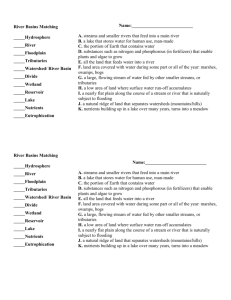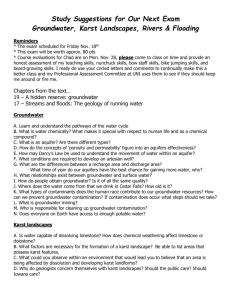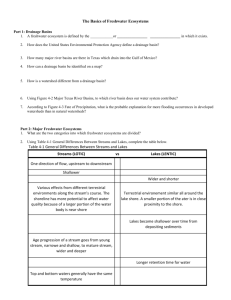Dynamic Planet By some random schmuck online, but I edited it a lot
advertisement
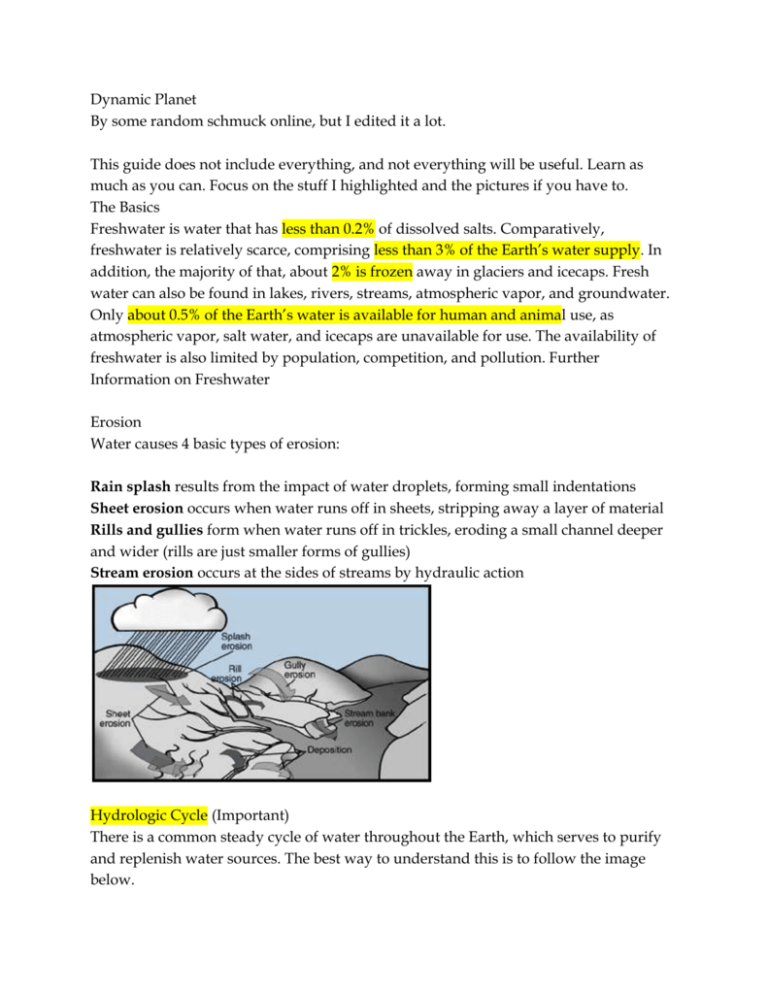
Dynamic Planet By some random schmuck online, but I edited it a lot. This guide does not include everything, and not everything will be useful. Learn as much as you can. Focus on the stuff I highlighted and the pictures if you have to. The Basics Freshwater is water that has less than 0.2% of dissolved salts. Comparatively, freshwater is relatively scarce, comprising less than 3% of the Earth’s water supply. In addition, the majority of that, about 2% is frozen away in glaciers and icecaps. Fresh water can also be found in lakes, rivers, streams, atmospheric vapor, and groundwater. Only about 0.5% of the Earth’s water is available for human and animal use, as atmospheric vapor, salt water, and icecaps are unavailable for use. The availability of freshwater is also limited by population, competition, and pollution. Further Information on Freshwater Erosion Water causes 4 basic types of erosion: Rain splash results from the impact of water droplets, forming small indentations Sheet erosion occurs when water runs off in sheets, stripping away a layer of material Rills and gullies form when water runs off in trickles, eroding a small channel deeper and wider (rills are just smaller forms of gullies) Stream erosion occurs at the sides of streams by hydraulic action Hydrologic Cycle (Important) There is a common steady cycle of water throughout the Earth, which serves to purify and replenish water sources. The best way to understand this is to follow the image below. More Info Evaporation: water into water vapor. Condensation: back to water. purifies water. Water needs a condensation nucleus, like a dust particle, in order to actually turn back into water. Evapotranspiration: really just called transpiration. Water being evaporated off of plants. Sublimation: ice straight to water. Infiltration: water going into the ground. percolation (not shown) is the water filtering through once it is in the ground. This serves to purify it. Precipitation: Both rain and snow. Yo, where’s the water at? (water by location in pie chart form. Useful to know) How much water is in each place. Looks kinda confusing I know, but if you can, know it. Water Budgets Basically, sum the total input and subtract the total output to get the water budget for a watershed. (If you have time, check this out http://www.brown.edu/Courses/GE0158/web2_revised/dennis/pages/budget.html) Lentic: water that is not moving. Lakes and all that. Lotic: water that is moving. Streams, rivers, n’ stuff. Streams Streams are a general name for all moving water. (not at all related to this but I find this hella cool: http://derekwatkins.files.wordpress.com/2011/07/dwatkins_usstreamnames.png) Stream Drainage Streams follow a general pattern based on topography. Drainage Channels form where runoff cuts into the ground. Profile (next page) In the case for large rivers, a delta or mouth of the river at sea level is a "Base Level", in fact, sea level itself is considered the "Ultimate Base Level". How can a waterfall be a base level? These pictures should shed some light on it. This picture shows a longitudinal profile, or a general profile of a river as compared to distance and elevation. As you can see in this picture, The origin is at the highest elevation, while the mouth is at the ultimate base level. By looking at this graphic, we can make some general assumptions: (Know these) 1. The closer to the origin you are, the faster the water will flow 2. The closer to the mouth you are, the slower the water will flow 3. Sediment will be scoured closer to the higher elevation 4. Sediment will be deposited at the lower elevations (this creates a delta #NewOrleans) 5. There is a higher stream gradient (slope of the stream) the closer to the origin you go 6. There is a lower stream gradient the closer to the mouth you go So how does this work into waterfalls? Let me show you with another concept: Downcutting! Downcutting is the deepening of a river channel relative to its surroundings. That is, how far does it dig into the ground. As natural examples tell us, The amount of downcutting on a river is dependent on where on the river it forms. Look at this example: (this wasn’t very clear to me the first time. Essentially, when a stream is higher up, closer to the source, it is going faster, and eroding more (specifically called downcutting), creating deeper ditches that the streams are in. When it is closer to the sink (the end of the river) it is not as fast, and doesn’t erode as much.) This picture shows what downcutting looks like on a normal river. At point “A”, the river is very fast moving and at a higher elevation to that of sea level, so it downcuts at a steady rate. At point “B”, the river is slowing down some, and is getting closer to sea level, so downcutting is considerably slower here than at Point “A”, and at Point “C”, downcutting is almost non-existent. However, science has shown us that downcutting does not continue down to sea level at the same speed in all cases. This is where we dive into the base level features. Let’s review what we have determined so far: Base level is the closest to sea level a river can go. Downcutting helps a river in its descent to ultimate base level. Now, if downcutting doesn’t always continue to sea level, what blocks its path? Well, in order to understand this, we have to add a little onto our definition of a base level. Base level is the closest to sea level a river can flow at any one location. In other words, in real time, the base level at Point “A” on our graphic could be different to the Base Level of point “B”. It all depends on the rock layers. This is where we get into the final focus point. At any one time, rock layers can dictate base levels. Geologically speaking, nothing impedes downcutting. However, at our timescale, we can witness downcutting happening before our very eyes. That is essentially what a waterfall is, an agent of downcutting. Look at this graphic of a waterfall: By looking at the graphic, we can determine a definition. A waterfall is a morphological feature defined by water flowing over a hard rock layer. In the case of most waterfalls, the water that flows over the falls erodes the softer layer at the base. Once it erodes enough, the unsupported hard layer above collapses. This is what makes a waterfall appear to “retreat”. So how does this fit into river morphology? It acts like a new point of origin. Look at this final graphic: In actuality, this is what a longitudinal profile looks like, if you were to make it precise. Though mine is a sloppy mess, hopefully you can see what I’m trying to get across. It has these stair steps, base levels, that act as a mini origin, restarting the morphological process. These don’t have to be waterfalls. Lakes, other rivers, and even man-made dams have this kind of effect. Channel Types (in pictures, water flows from where there are lots of little lines to where there is just one) Know the stuff below here. Dendritic Drainage is the most common and looks similar to a tree. Dendritic Drainage occurs where a region is above a single type of bedrock (homogeneous). Which gives the entire area a similar resistance to erosion and therefore a seemingly random placement of tributaries. Most tributaries will join a larger stream at an acute angle. Parallel Drainage generally forms where there is a large hill. They develop in areas with parallel regions of rock that are harder to erode. Trellis Drainage Patterns form where there is a folded topography, like the Appalachian mountains. Tributaries enter the main stream at near right angles. Rectangular drainage patterns are found in regions that have undergone faulting. Streams follow the path of least resistance and thus are concentrated in places were exposed rock is the weakest. Radial drainage patterns develop around a central elevated point. These patterns are common to such conically shaped features as volcanoes. Centripetal drainage patterns are the opposite of radial ones. They are common in basins like in the United States Southwest region, where streams flow downward to a central point. Deranged or contorted patterns develop from the disruption of a pre-existing drainage pattern. In this picture, the stream began as a dendritic stream but was overrun by a glacier. After receding, the glacier left behind fine grain material that form wetlands and deposits that dammed the stream to impound a small lake. The tributary streams appear significantly more contorted than they were prior to glaciation. Braided Stream Channel These type of streams form where a sediment rich stream slows normally near where the stream grade changes from steep to more shallow. Than it divides into many smaller interwoven channels. they are also generally wide and shallow Meandering Channel Meanders generally form on a flat area with a broad floodplain. A meandering stream has a sinuosity ratio greater than 1.5, with sinuosity = length of stream along channel/actual straight-line distance traveled by stream Anastomose Channel Multiple channels that divide and reconnect, but not as easily as in a braided channel Alluvial Landforms Once a stream reaches a base level it forms a large fertile valley due to its meandering: Flood Plain: A flood plain is the flat area that tends to be covered in water when the river rises. As a flood increases the rivers size it slows the river down causing it to drop sediment which in turn allows for very fertile soil. Natural Levee: A natural levee is formed when sediment(alluvium) is deposited along the edge of the stream forming a ridge Meanders: A meander is a bend in a stream. Meanders are prevalent in older streams. Meanders have erosion on the outer bank and deposition on the inner bank. A point bar forms where the water going through a meanders drops alluvium on the inner bank The neck is the point of land between the two edges of a meander. The cutoff occurs when the stream erodes through the neck causing the river to be back to a straight course. The result is an Ox-bow lake which is a separate body of water from the stream Deltas Deltas are formed when rivers meet large bodies of water like oceans. They are classified as follows: Constructional river-dominated elongate (digitate, bird foot delta) lobate Destructional tide-dominated wave-dominated cuspate (tooth shaped delta) Other names for types of deltas: Arcuate delta, Estuarine delta Stream Order Strahler developed a system known as stream order that helps determine how many tributaries a particular stream has and how large that stream is. Basically, start with the smallest stream, which has no tributaries; this is a first-order stream. Two first order streams join to make a second order stream, and so on. If a second-order stream joins a first-order stream, the resulting stream is still second-order. This image explains it in a picture rather than in words: Lakes (Know this stuff) Lakes are stratified into several layers based on temperature and location. Lakes are also classified by their nutrient levels and oxygen concentrations. There are many ways of forming a lake. A lake is a body of water completely surrounded by land. More than 90% of Earth’s surface waters are contained in lakes. Less than 1% of Earth’s surface waters are found in rivers and streams at any moment in time. The origin of most lakes is not related to stream activity. Conditions necessary for the formation and continued existence of a lake: 1. A natural basin with a restricted outlet; 2. Sufficient input of water to keep the basin at least partially filled. Most of the world’s lakes contain fresh water. Less than 40% of lake waters are salty. Any lake that has no natural drainage outlet, either as a surface stream or as a sustained subsurface flow, will become saline. The water balance of most lakes is maintained by surface inflow, sometimes combined with springs and seeps from below the lake surface. Lakes are most common in regions that were glaciated within the relatively recent geologic past because glacial erosion and deposition have deranged the normal drainage patterns and have created innumerable basins. The series of large lakes in eastern and central Africa is due to major crustal movements and volcanic activity. Thousands of small lakes in Florida were formed by sinkhole collapse where rainwater dissolved calcium from massive limestone bedrock. Most lakes are very temporary features in the natural landscape, geologically speaking. Few lakes have been in existence for more than a few thousand years: 1. Inflowing streams bring sediments to fill them up; 2. Outflowing streams cut channels that progressively deepen and drain lakes; 3. As lakes become more shallow, an increase in plant growth accelerates the process of infilling. Dry lake beds located in desert regions are called playas. When temporarily filled by intermittent streams these bodies of water are called playa lakes. Permanent desert lakes are nearly always products of either subsurface structural conditions that provide water from a permanent spring or of exotic streams that have their source in nearby mountain. Lakes may affect climate and weather: 1. It is generally more humid around lake areas; 2. Because water warms and cools more slowly than land, temperatures near lakes are generally milder than temperatures at the same latitude but more distant from lakes. Reservoirs List of reservoirs by area 1. Lake Volta (8,482 sq km or 3,275 sq mi; Ghana) 2. Smallwood Reservoir (6,527 sq km or 2,520 sq mi; Canada) 3. Kuybyshev Reservoir (6,450 sq km or 2,490 sq mi; Russia) 4. 5. 6. 7. 8. 9. 10. Lake Kariba (5,580 sq km or 2,150 sq mi; Zimbabwe, Zambia) Bukhtarma Reservoir (5,490 sq km or 2,120 sq mi; Kazakhstan) Bratsk Reservoir (5,426 sq km or 2,095 sq mi; Russia) Lake Nasser (5,248 sq km or 2,026 sq mi; Egypt, Sudan) Rybinsk Reservoir (4,580 sq km or 1,770 sq mi; Russia) Caniapiscau Reservoir (4,318 sq km or 1,667 sq mi; Canada) Lake Guri (4,250 sq km or 1,640 sq mi; Venezuela) List of reservoirs by volume 1. Lake Kariba (180 cu km or 43 cu mi; Zimbabwe, Zambia) 2. Bratsk Reservoir (169 cu km or 41 cu mi; Russia) 3. Lake Nasser (157 cu km or 38 cu mi; Egypt, Sudan) 4. Lake Volta (148 cu km or 36 cu mi; Ghana) 5. Manicouagan Reservoir (142 cu km or 34 cu mi; Canada) 6. Lake Guri (135 cu km or 32 cu mi; Venezuela) 7. Williston Lake (74 cu km or 18 cu mi; Canada) 8. Krasnoyarsk Reservoir (73 cu km or 18 cu mi; Russia) 9. Zeya Reservoir (68 cu km or 16 cu mi; Russia) Groundwater Groundwater is water that is in the ground. It exists in the pore spaces and fractures in rock and sediment. It originally was rainwater or snow. Water will move down into the earth until it reaches a layer of soil where it can not penetrate. This layer is called the impenetrable or impermeable layer. The uppermost reaches of this water is called the water table. Facts: Groundwater makes up about 1% of the water on Earth. That's about 35 times the amount of water in lakes and streams. It occurs everywhere beneath the Earth's surface, but is usually restricted to depths less that about 750 meters. The surface below which all rocks are saturated with groundwater is the water table. Further information on Groundwater Hydraulic Head The depth of groundwater in two different places, when measured, can give hydraulic gradient, basically a calculation of slope. hydraulic gradient (I) = (h1 - h2) / d where h1 and h2 are two different heights, and d is the distance between them. This allows us to calculate the velocity of groundwater flow, if we know porosity (a unitless percentage that describes what percentage of a rock, gravel, or sand is empty) and permeability (the variable K). groundwater velocity (V) = hydraulic conductivity (K) x hydraulic gradient (I) / porosity Darcy also found out how to determine groundwater discharge using this information and the area the water flows through. discharge (Q) = hydraulic conductivity (K) x hydraulic gradient (I) x area (A) Some resources on groundwater discharge and aquifers More resources on groundwater discharge and aquifers Karst Topography Karst topography is a distinctive landform assemblage developed as a consequence of the dissolving action of water on carbonate bedrock (usually limestone, dolomite, or marble). Types of Karst features include sinkholes, solution valleys, springs, disappearing streams, and caves developed as a consequence of subsurface solution. Sinkholes are commonly funnel-shaped and broadly open upward. Sinkholes may be a few feet to more than 100 feet in depth, though usually ranging from 10 to 30 feet. Sinkhole diameter sizes range from a few square yards to several acres in area. Another name for sinkholes are cenotes. Solution valleys (or Karst valleys) are the remains of former surface stream valleys whose streams have been diverted underground as karst developed. They may develop a series of sinkholes in the valley floor. Karst springs occur where the groundwater flow discharges from a conduit or cave. Karst springs or "cave springs" can have large openings and discharge very large volumes of water. Sinkholes and sinking streams that drain to a large karst spring can be many miles away from the spring. Streams flowing along the surface may enter a sinkhole as a "disappearing stream" and flow underground for some distance to reappear at the surface. Caves (or caverns) are large, open underground areas occurring in massive limestone depositions at or near the surface.
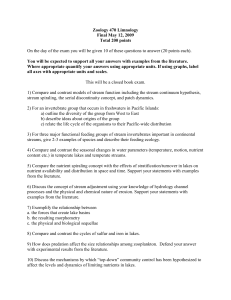
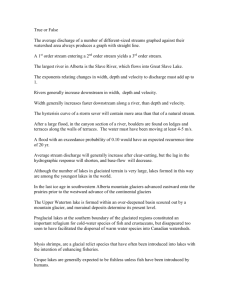
![dynamic_planet_notes[1]](http://s3.studylib.net/store/data/007076439_1-69e76760cbc32fcb4f029e41a163992e-300x300.png)


